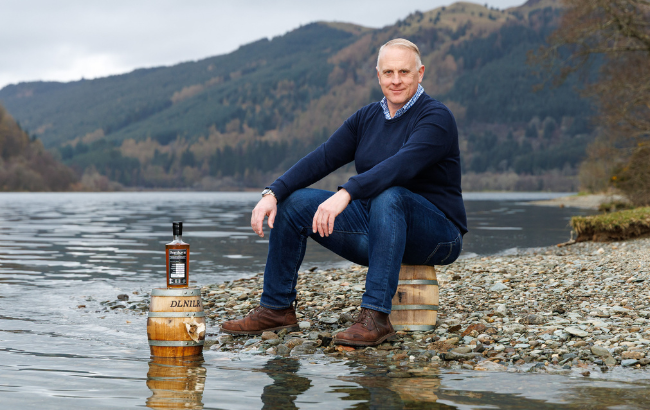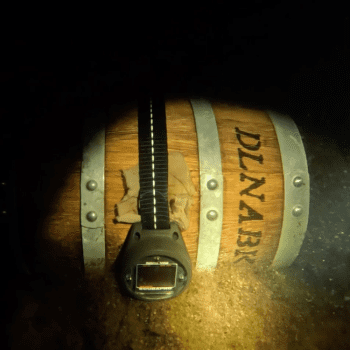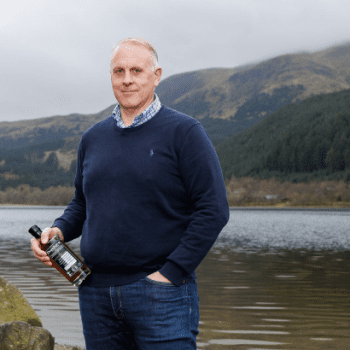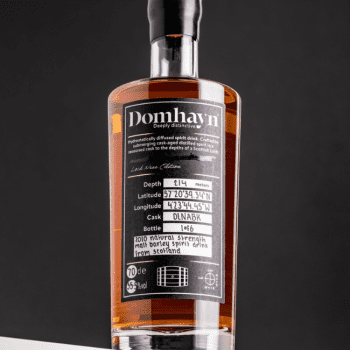Domhayn takes cask ageing to the depths of Loch Ness
By Georgie CollinsScottish spirits brand Domhayn has taken a ‘pioneering’ approach to maturing spirits by submerging casks into the ‘mysterious depths’ of Loch Ness in the Scottish Highlands.

Using a pioneering hydrostatic diffusion technique developed in-house, Domhayn (pronounced ‘doyn’ and named after the Gaelic word for ‘deep’) has managed to alter the composition of a spirit in ‘unprecedented ways’, representing what is being described as a potential game changer for the drinks industry.
The technique sees a spirit-filled wooden cask plunged to the depths of Loch Ness, approximately 214 metres (702 feet) beneath the surface. The submersion causes extreme hydrostatic pressure, triggering a unique interaction between the wood and the spirit via both extraction and absorption, which subtly alters the spirits molecular profile.
This ‘revolutionary’ process is said to enhance and smooth the spirit within, creating unique flavour profiles compared to those achieved by traditional maturation.

Domhayn founder James Patterson, who has a background in civil engineering, tells The Spirits Business that its inaugural release cask spent approximately half an hour submerged within the loch. “There’s lots of technical aspects to it. The very first experiment that we did, the cask was submerged for about the same time, and then we sent samples of the spirit, before and after, to Oxford University to be analysed, and the results came back very positive.” As such, he says there wasn’t much need to change the timing variable because they were already producing an interesting result. “So for the next few casks, we just stuck to that timing. We can do longer,” he says, “but when you start going beyond a few hours, then the technique changes and gets much more expensive.”
The limit to how deep the cask can be submerged is approximately 500 metres, Patterson explains, on account of the structural limit of wood, “but there’s no need to go so deep. I mean, you could do just to see what results you got, but 500 metres is about the limit.”
In order to submerge the cask, which had a capacity of five litres of spirit, Patterson shares that it was a simple process. “To be honest, there’s lots of different ways that you can take the cask down, but there’s no point in over engineering something – if you can keep it simple, then keep it simple,” he says, noting that it is “very much a question of weight, because, of course, the cask is wood, so there’s an element of buoyancy, so it needs to be sunk – it needs to be heavy enough to sink.” After that, he says, it’s just a question of leaving it down there. “It doesn’t have to be especially long, because it’s the act of compression as you go down, and then the function of decompression as you come up, that generates the transformation in the flavour profile.”
The location of Loch Ness was chosen for a number of reasons, one being it is one of Scotland’s few lochs with sufficient depth for the submersion. “Its also the biggest loch in terms of volume of water, so it’s a majestic, impressive, large place,” as well as easy for access and familiar.
Molecular composition

Patterson explains that the five-litre capacity of the cask was chosen because the smaller size has a more noticeable impact on the spirit. “The more liquid you’ve got in the cask, the more the cask has got to work to deliver the transformation of the spirit,” he says. “So if you did this with a normal sized cask [approximately 200-litre capacity] the result would be much more difficult to detect. So compacting things concentrates the effect.”
The transformation of the spirit that Patterson refers to is the change in its molecular levels. Put simply, the spirit inside the cask contains more than 11,000 different molecular compounds. Through Domhayn’s underwater submersion process, some of these molecules increased in prevalence while others decreased in quantity. This molecular transformation was scientifically verified through mass spectrometry analysis by the Department of Chemistry at Oxford University.
The process was found to change the spirit at a microscopic level, creating a different molecular composition compared to traditional maturation methods. This scientific approach therefore allows for an objective measurement of how the spirit’s molecular structure changes, beyond just subjective taste perceptions.
Inaugural release
Domhayn’s inaugural release comes from the cask known as DLNABK, which was submerged in Loch Ness on 14 February 2025. The cask contained a 2010 single malt barley spirit, categorised as such due to this unique production method that does not fit within the definition of a Scotch whisky or any other spirit category.

Bottled at its natural strength of 55.5% ABV, only six bottles are in existence, each of which can be traced back to the precise location coordinates where the cask rested on the loch bed, ensuring a unique provenance for every release and creating a tangible link between the spirit and the environment that shaped it.
The bottles of Domhayn will be sold exclusively via an online monthly auction at www.whiskyauctioneer.com, starting from tomorrow (25 April). Initially, only one bottle will be released for auction per month.
Patterson says they don’t have an expected sale price at the moment, but a reserve will be in place for the auction.
It is believed the buyers of these first bottlings will likely be whisky collectors, and interest has been expressed from as far as South Korea and the US so far. “It’s not your standard spirit drink. It’s been on a journey like no other spirit drink has been on, and it’s changed in a way that no one else has tasted before, so that’s part of the reason for choosing an auction – how do you put a price on something that’s that unique? So the idea is to just let the market decide; let the enthusiasts and the collectors and the connoisseurs decide what the value of this very first bottle should be.”
In other cask innovation news, earlier this week Dhavall Gandhi revealed a whisky cask designed for hot climates.
Related news
Liqueurs: innovation and adaptability spearhead success
